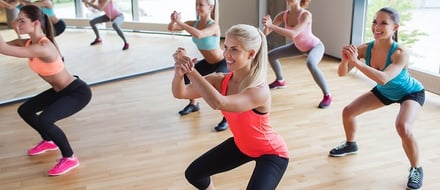MAKE A SPLASH
THIS SUMMER

Join Now For $0 Enrollment!
Learn MorePosted By: Chicago Athletic Clubs /

You might think that to burn the most calories, you need to spend as much time as possible at the gym, on the bike trail or running path. That’s one strategy, but it’s neither the only nor the best one; thankfully there are a number of factors other than time that can boost your burning potential. Make these small updates to your current routine and you can supercharge your sessions to melt flab and ignite your metabolism; all without spending a minute more sweating, according to Donna Walker, an NASM-certified personal trainer at Chicago Athletic Clubs.
Warm up well
Start each workout doing 10 minutes of gentle versions of the moves that mimic what’s ahead. For instance, runners can start with a series of knee pulls, butt kicks, and leg swings. Before a strength workout, move through the motions of squats, curls, or lifts with no weight or just the bar before loading up. You’ll not only burn calories doing these motions, warming up this way primes your body to burn the most calories during the main event, Walker says. You’ll be able to lift heavier or push harder, racking up a bigger total for the whole session.
HIIT it hard
High-intensity interval training (HIIT) isn’t easy — it involves pushing yourself to nearly your max for short bursts, with brief rests to catch your breath in between — but the calorie-burning benefits are greater. “Your body has to really step up a notch,” says Irene Lewis-McCormick, M.S., C.S.C.S., author of “The HIIT Advantage: High-Intensity Workouts for Women.” That includes both during and long after you leave you gym. Your body expends extra energy for up to 36 hours as it recovers from such an intense effort.
So, swap out one or two sessions of slow, steady cardio per week for HIIT, Walker suggests. One well-known HIIT protocol, called Tabata, involves eight rounds of 20 seconds “on” (working so hard you’re gasping for breath), followed by 10 seconds “off” to recover. You can do it on cardio machines like bikes or treadmills, or do full-body movements like jump squats, mountain climbers or burpees.
Lower slowly
Turn up your burn in the weight room by paying closer attention to the second half of each lift, or what’s called the eccentric phase, Walker says. Keep your muscles engaged and slowly lower your weights or lengthen your muscles; don’t just let gravity pull your arm back down after a bicep curl or bring your knees back in after a leg press, for example. “You burn more calories because you’re actively seeking to condition and change those muscles,” she says. What’s more, the extra lean muscle you build burns more calories all day, even when you’re just sitting on the couch.
Recover right
Whether you’re crushing a HIIT workout or lifting weights, don’t take the terms “rest” and “recovery” literally. Coming to a cold stop between hard efforts not only can make you feel woozy and faint, it means missing an opportunity to zap fat, Walker says. Instead, aim for active recovery between sets. Jump rope, step up on a bench, or even just march in place or pace to keep your heart rate elevated, muscles moving, and calories burning.
Make the leap
Jump squats, burpees, jumping jacks — these types of bounding movements all qualify as jump training, a.k.a. plyometrics. Using plyos during the “on” period of a HIIT workout or as active recovery between weightlifting sets triggers extra calorie burning since the movements require a large amount of energy, Lewis-McCormick says. To ensure proper form and avoid injury, focus on lifting the crown of your head and your chest, rolling your shoulder blades back, pulling your navel toward your spine, and landing softly on the balls of your foot, Walker recommends.
Mix things up
You may be devoted to one Spin or yoga instructor’s class, but falling into a rut with your routine can rob you of calorie burning, Walker says. Trying new teachers, classes, and types of activities keeps your body guessing and your mind engaged, ultimately helping you burn the most calories every day, week, and session. “Once you start to feel comfortable with a particular movement, it’s time to change,” Walker says. “When you’re exercising, you shouldn’t really want to be comfortable. Aim to be pushed if you want to change [your body]. Change is inherently uncomfortable.”
© 2025 Chicago Athletic Clubs. All Rights Reserved. Privacy PolicyEmployee Login
https://www.chicagoathleticclubs.com/
https://www.chicagoathleticclubs.com/services/personal-training/
0
5000
true